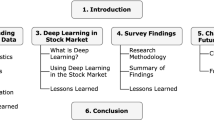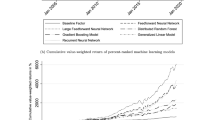Abstract
This study investigates the informativeness of realized higher moments of stock index returns, namely, realized skewness and kurtosis, in explaining trading activity in the futures market to investigate whether information flows from price risk to trading activity. By analyzing high-frequency data covering a twelve-year period, we discover that futures trading activity can be attributed to high-moment market risks, as observed in the significant explanatory power of realized high moments even after controlling for other risk factors. The results are robust to the use of various adjusted measures of high-moment risk, their subcomponents, various measures of trading activity, and data attributes. This study suggests that realized high moments are a market risk and cannot be combined with volatility risk and other risk measures. Most importantly, this study finds that there exists a flow of market information from price risk to trading activity.
Similar content being viewed by others
Data availability
Data supporting the empirical work of this study are from the Taiwan Futures Exchange. Restrictions apply to the availability of these data, which were used with permission for this study. Data are available from the author with the permission of the Taiwan Futures Exchange.
Notes
This inference is consistent with the conclusions of Hu, Li, Xiang, and Zhou (2023), who compared China and provided evidence to support that markets with a higher proportion of individual investors will be more sensitive to higher moment risks, which is quite different to mature markets.
Liu, Choo, Lee & Lee (2023) also suggest considering the sub-components of trading activity, they decompose trading volume into short-term and long-term messages and re-examine the relationship between trading volume and risk respectively.
We would like to thank the reviewers for suggesting the development of a VAR model to further account for the interaction between realized high-moment risk and trading activity and to control for the impact of risk-neutral high- moment risk calculated from option prices.
The 5-min intervals suggested by Andersen and Bollerslev (1999) are optimal in simulating the mean square error.
TVol represents the total trading volume of contract transactions during a certain period, and its components include TNum, which represents the total number of shares traded, and TSize, which represents the number of shares per trade. These indicators are included in our research as proxies for trading activity.
Following Brunnermeier (2009), the 2008 financial crisis is defined as the period from August 2007 to December 2008.
We also use integration areas [0.9S, 1.1S] and [0.8S, 1.2S] to calculate RNS and then examine the return predictive effect of RNS on spot market returns during periods of sentiment-driven overreaction. Both of the resulting effects are significant and similar to the results obtained using the integration area [0.85S, 1.15S].
For fitting a smoothing IV curve in calculating RNS, we follow Jiang and Tian (2005, 2007) by applying cubic splines. If the lowest strike price is higher than 0.85S or the highest strike price is lower than 1.15S in the sample, we conduct a linear extrapolation with the slope, which is set as the slope value adjacent to the cubic spline. Based on the aforementioned fitted IV curve, we translate the extrapolated IVs obtained for all strike prices into option prices using the Black–Scholes (1973) model. Finally, we derive RNS from the option prices using Eqs. (1a)–(6a).
References
Amaya D, Christoffersen P, Jacobs K, Vasquez A (2015) Does realized skewness predict the cross–section of equity returns? J Financ Econ 118:135–167
Andersen TG, Bollerslev T (1998) Answering the skeptics: yes, standard volatility models do provide accurate forecasts. Int Econ Rev 39:885–905
Andersen TG, Bollerslev T (1999) Forecasting financial market volatility: sample frequency vis-à-vis forecast horizon. J Empir Financ 6:457–477
Andersen TG, Bollerslev T, Diebold FX, Labys P (2003) Modeling and forecasting realized volatility. Econometrica 71:579–625
Bakshi G, Madan D (2000) Spanning and derivative security valuation. J Financ Econ 55:205–238
Bakshi G, Cao C, Chen Z (1997) Empirical performance of alternative option pricing models. J Finance 52:2003–2049
Bakshi G, Cao C, Chen Z (2000) Pricing and hedging long-term options. J Econ 94:277–318
Bakshi G, Kapadia N, Madan D (2003) Stock return characteristics, skew laws, and the differential pricing of individual equity options. Rev Financ Stud 16:101–143
Banerjee S, Kremer I (2010) Disagreement and learning: dynamic patterns of trade. J Finance 65:1269–1302
Bessembinder H, Seguin PJ (1992) Futures-trading activity and stock price volatility. J Finance 47:2015–2034
Bollerslev T, Wright JH (2001) High-frequency data, frequency domain inference, and volatility forecasting. Rev Econ Stat 83:596–602
Borochin P, Chang H, Wu Y (2020) The information content of the term structures of risk- neutral skewness. J Empir Financ 58:247–274
Brunnermeier MK (2009) Deciphering the liquidity and credit crunch 2007–2008. J Econ Perspect 23:77–100
Carlin BI, Longstaff FA, Matoba K (2014) Disagreement and asset prices. J Financ Econ 114:226–238
Chan K, Fong WM (2000) Trade size, order imbalance, and the volatility-volume relation. J Financ Econ 57:247–273
Chang E, Cheng J, Khorana A (2000) An examination of herd behavior in equity market: an international perspective. J Bank Finance 24:1651–1679
Chen N-F, Cuny CJ, Haugen RA (1995) Stock volatility and the levels of the basis and open interest in futures contracts. J Finance 50:281–300
Chen J, Hong H, Stein JC (2001) Forecasting crashes: trading volume, past returns, and conditional skewness in stock prices. J Financ Econ 61:345–381
Chou RK, Wang GH (2006) Transaction tax and market quality of the Taiwan stock index futures. J Futur Mark 26:1195–1216
Dai Y, Jiang Y, Long H, Wang H (2023) Does realized skewness predict the cross-section of Chinese stock returns? Financ Res Lett 58:104363
Do HX, Brooks R, Treepongkaruna S, Wu E (2014) How does trading volume affect financial return distributions? Int Rev Financ Anal 35:190–206
Doran JS, Tarrant BC, Peterson DR (2007) Is there information in the volatility skew? J Fut Mark 27:921–959
Easley D, O’Hara M (1992) Time and the process of security price adjustment. J Finance 47:577–605
Friesen GC, Zhang Y, Zorn TS (2012) Heterogeneous beliefs and risk-neutral skewness. J Financ Quant Analy 47:851–872
Fung J (2007) The information content of option implied volatility surrounding the 1997 Hong Kong stock market crash. J Fut Mark 27:555–574
Giot P, Laurent S (2007) The information content of implied volatility in light of the jump/continuous decomposition of realized volatility. J Fut Mark 27:337–359
Giot, p., Laurent, S., and Petitjean, M. (2010) Trading activity, realized volatility and jumps. J Empir Financ 17:168–175
Girma P, Mougoué M (2002) An empirical examination of the relation between futures spreads volatility, volume, and open interest. J Fut Mark 22:1083–1102
Harris M, Raviv A (1993) Differences of opinion make a horse race. Rev Financ Stud 6:473–506
Hong H, Stein JC (2003) Differences of opinion, short-sales constraints, and market crashes. Rev Financ Stud 16:487–525
Hsieh WG (2004) Regulatory changes and information competition: the case of Taiwan index futures. J Futur Mark 24:399–412
Hu D, Li X, Xiang G, Zhou Q (2023) Asset pricing models in the presence of higher moments: theory and evidence from the US and China stock market. Pac Basin Financ J 79:102053
Hueng C, McDonald J (2005) Forecasting asymmetries in aggregate stock market returns: evidence from conditional skewness. J Empir Financ 12:666–685
Hutson E, Kearney C, Lynch M (2008) Volume and skewness in international equity markets. J Bank Finance 32:1255–1268
Jones CM, Kaul G, Lipson ML (1994) Transactions, volume, and volatility. Rev Financ Stud 7:631–651
Kyle A (1985) Continuous auctions and insider trading. Econometrica 53:1315–1335
Liu M, Choo WC, Lee CC, Lee CC (2023) Trading Volume and realized volatility forecasting: evidence from the China stock market. J Forecast 42:76–100
Lucia J, Pardo A (2010) On measuring speculative and hedging activities in futures markets from volume and open interest data. Appl Econ 42:1549–1557
Neuberger A (2012) Realized skewness. Rev Financ Stud 25:3432–3455
Newey WK, West KD (1987) A simple, positive semi-definite, heteroskedasticity and autocorrelation consistent covariance martrix. Econometrica 55:703–708
Roope M, Zurbruegg R (2002) The intra-day price discovery process between the Singapore Exchange and Taiwan Futures Exchange. J Futur Mark 22:219–240
Schwert GW, Seguin PJ (1990) Heteroskedasticity in stock return. J Finance 45:1129–1155
Wang T, Huang Z (2012) The relationship between volatility and trading volume in the Chinese stock market: a volatility decomposition perspective. Ann Econ Financ 13:211–236
Wei SY, Lin LW, Yan S, Zhu LJ (2019) Empirical analysis on price-volume relation in the stock market of China. Int J Econ Financ Issues 9:94–103
Xu J (2007) Price Convexity and skewness. J Financ 62:2521–2552
Zhang L, Mykland PA, AÏt-Sahalia, Y. (2005) A tale of two time scales: determining integrated volatility with noisy high-frequency data. J Am Stat Assoc 100:1394–1411
Zhang C, Ma H, Arkorful GB, Peng Z (2023a) The impacts of futures trading on volatility and volatility asymmetry of Bitcoin returns. Int Rev Financ Anal 86:102497
Zhang H, Jin C, Bouri E, Gao W (2023b) Realized higher-order-moments spillovers between commodity and stock markets: evidence from China. J Commod Mark 30:100275
Author information
Authors and Affiliations
Corresponding author
Additional information
Publisher's Note
Springer Nature remains neutral with regard to jurisdictional claims in published maps and institutional affiliations.
Appendix
Appendix
According to Bakshi and Madan (2000) and Bakshi et al. (2003), risk-neutral return density moments can be expressed by quadratic, cubic, and quartic payoffs (Vt, Wt, and Qt, respectively, in Eqs. (13), (14), and (17)), which are linear combinations of current out-of-the- money (OTM) option prices. The ex-ante estimates of risk-neutral skewness and kurtosis with τ period at time t (RNSt and RNKt, respectively) in Eqs. (10) and (11) are computed as follows:
where Vt(τ), Wt(τ), and Qt(τ) represent the quadratic, cubic, and quartic price return calculated at time t for τ-expiring contracts, respectively; Ct(τ; K) and Pt(τ; K) are the price of the call and put options written on the underlying stock index at time t, respectively, with the strike price K and τ until expiration; St is the price of the underlying stock index at time t; and r is the risk-free rate. To empirically estimate skewness and kurtosis, we need to approximate the integrals in Eqs. (13)–(15) using observed option prices. We use a trapezoidal approximation to estimate the integrals using discrete data. Based on our selection of [0.85S, 1.15S] as the integration area in Eqs. (13)–(15),Footnote 10 we calculate RNS and RNK at time t over the period [t, t + τ].Footnote 11 In addition, to avoid the bid-ask bounce problem, the midpoint of the quote rather than the transaction price is used to compute RNS and IV (Bakshi et al. 1997, 2000).
In this study, we linearly interpolate the skews at the two nearest maturities, RNSt(τ1) and RNSt(τ2), to obtain the skewness at a fixed 30-calendar-day (τ30) horizon. It is given as follows:
where \(\theta = (\tau_{2} - \tau_{30} )/(\tau_{2} - \tau_{1} )\) and \(\tau_{1} \tau_{2}\), and \(\tau_{30}\) are the expiration times for near-term options, next- term options, and 30-day options, respectively. For each daily OSkew, we first calculate the skewness at every 5-min interval and then average it over the interval of the day, where the 5-min skewness is calculated using call and put prices, as shown in Eq. (10).
Similarly, the same method is used to calculate kurtosis, denoted as OKurt, at a fixed interval of 30 days (\(\tau_{30}\)) using Eq. (11).
Rights and permissions
Springer Nature or its licensor (e.g. a society or other partner) holds exclusive rights to this article under a publishing agreement with the author(s) or other rightsholder(s); author self-archiving of the accepted manuscript version of this article is solely governed by the terms of such publishing agreement and applicable law.
About this article
Cite this article
Yuan, SF. Realized higher moments and trading activity. Rev Quant Finan Acc 62, 971–1005 (2024). https://doi.org/10.1007/s11156-023-01227-3
Accepted:
Published:
Issue Date:
DOI: https://doi.org/10.1007/s11156-023-01227-3




